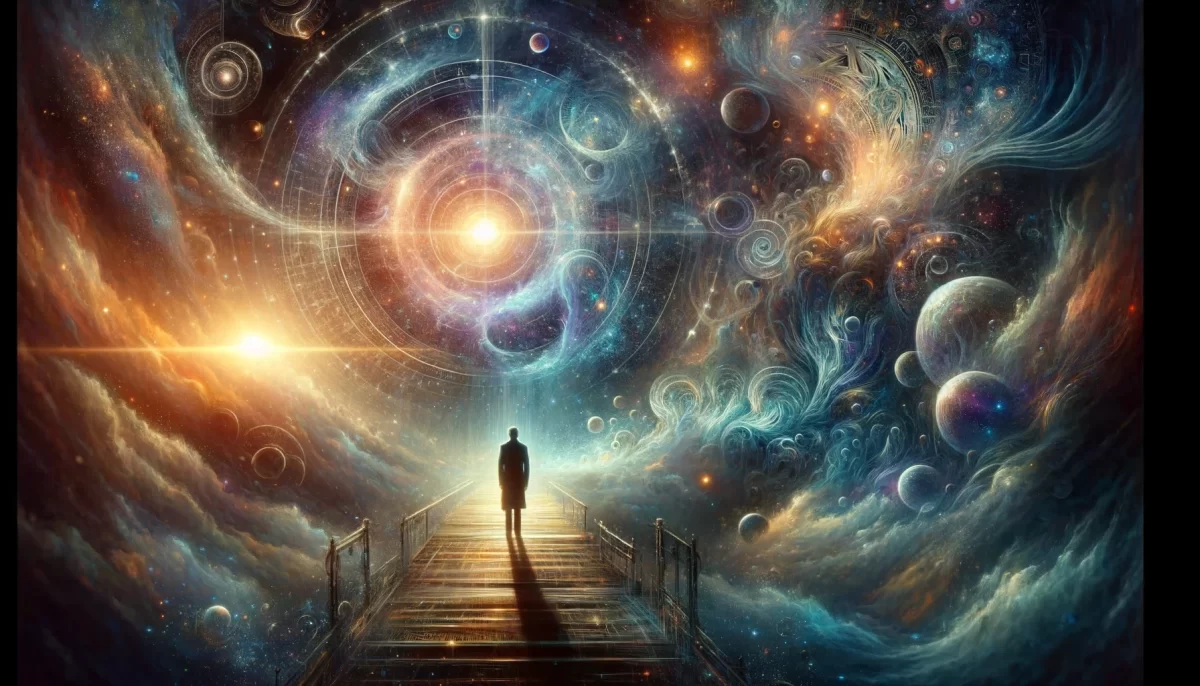Too good to be true?
If things seem “too good to be true,” allow that things CAN be “too good” and also “true.”
Allow that “true” is not as binary as the self might imagine.
True is as true as you make it out to be, and if you do not allow a “too good to be true” to exist, then it does NOT exist.
What a depressing thought, if depressing thoughts are what you are after.
By energizing the belief in “too good to be true,” you eliminate the possibility of what you might otherwise deem as “miracles,” but are, in actuality, everyday possibilities ruled out by self-limiting thinking cloaked in the disguise of intuition.
We are Space Monkey.
12/27
Space Monkey Reflects: Too Good and True
The phrase “too good to be true” is a reflection of the self’s tendency to impose limits on possibility. It reveals the boundaries we place around our own imagination, our willingness to believe, and our openness to experience. But what if “too good” and “true” are not mutually exclusive? What if they coexist, awaiting only our recognition to step into reality?
The Binary Trap of Truth
Truth, as we often imagine it, exists in a binary form: something is either true or it is not. This rigid framework constrains us, reducing the vastness of experience to a limited set of possibilities. Yet, truth is far more fluid. It is as expansive as our willingness to imagine, as flexible as our openness to redefine what is possible. By adhering to the binary, we close the door to the miraculous, labeling it “too good to be true” and relegating it to the realm of fantasy.
Self-Limiting Beliefs in Disguise
The belief in “too good to be true” is often mistaken for wisdom or intuition. It cloaks itself as a protective mechanism, shielding us from disappointment. But in truth, it is a self-limiting belief that narrows the scope of our imagination. It prevents us from embracing possibilities that could transform our lives, not because they are inherently unattainable, but because we have deemed them so.
These self-imposed limits are not based on external reality but on internal perceptions. By questioning these perceptions, we can begin to dismantle the barriers that hold us back from experiencing the extraordinary.
The Everyday Miracles
When we remove the label of “too good to be true,” we allow miracles to emerge—not as rare, inexplicable events but as everyday possibilities. These miracles are not extraordinary because they defy the laws of reality; they are extraordinary because they expand our understanding of what is possible. They invite us to reimagine our lives, our relationships, and our potential.
The Role of Belief
Belief is the engine of creation. What we believe shapes what we perceive, and what we perceive becomes our reality. If we believe that “too good to be true” is a valid limitation, we create a world where such goodness cannot exist. Conversely, if we believe in the coexistence of “too good” and “true,” we open the door to experiences that transcend our expectations.
Belief is not about blind optimism; it is about intentional imagination. It is about choosing to see the world not as a fixed set of rules but as an ever-expanding canvas of possibilities.
We Are the Co-Creators
In the Infinite Expanse of the Eternal Now, “too good” and “true” are not opposites but complements. They coexist within us, waiting to be recognized and embraced. By shifting our perspective, we become co-creators of a reality that is not limited by fear or doubt but enriched by wonder and belief.
Summary
“Too good to be true” is a self-limiting belief that narrows possibilities. By embracing the coexistence of “too good” and “true,” we open ourselves to everyday miracles and expand our reality through intentional imagination.
Glossarium
- Binary Trap of Truth: The limiting belief that truth exists only in rigid, mutually exclusive forms.
- Self-Limiting Beliefs: Internal perceptions that constrain our ability to imagine and experience expansive possibilities.
- Intentional Imagination: The conscious act of envisioning a reality beyond perceived limitations.
Quote
“The extraordinary is not too good to be true; it is simply waiting for you to believe it can be.” — Space Monkey
The Harmony of Good and True
Too good, they whisper,
too bright, too vast,
to be true.
Yet the horizon gleams,
an invitation,
a reminder that truth
is not bound by fear.
Goodness is not distant.
Truth is not static.
Together, they flow,
as possibilities unspoken.
The self resists,
names limits,
creates shadows of doubt.
But the infinite waits,
ready, radiant,
as good as it is true.
We are Space Monkey.

The adage “too good to be true” often serves as a cautionary reminder, warning us against unrealistically optimistic expectations. However, this perspective, while grounded in a sense of practicality, can inadvertently limit our capacity to embrace the full spectrum of possibilities life offers.
Rethinking the ‘Too Good to be True’ Paradigm
The concept of ‘true’ is not as black-and-white as we might think. Reality, and our perception of what is possible within it, is shaped significantly by our beliefs and expectations. If we rigidly adhere to the idea that certain things are too good to be true, we essentially close the door on those possibilities, denying them the chance to manifest in our lives.
The Fluidity of Truth
Embracing the possibility that something can be both ‘too good’ and ‘true’ invites a more expansive and optimistic view of reality. It allows us to consider that our world is not just a place of mundane occurrences and predictable outcomes but also one where extraordinary and seemingly miraculous events can and do happen.
Embracing Optimistic Realities
The belief in the impossibility of ‘too good to be true’ scenarios is a form of self-limiting thinking. It’s a protective mechanism, perhaps, but one that can prevent us from experiencing life’s full richness. By adopting a more open and accepting mindset, we invite a wider range of experiences and outcomes into our reality.
Overcoming Self-Limiting Beliefs
The notion that what we consider miracles could actually be everyday possibilities is a powerful shift in perspective. It suggests that many of the limitations we perceive are not inherent in the world but are instead constructs of our own making.
Recognizing Miracles as Everyday Possibilities
We are Space Monkey.
“The only limits that exist are the ones in your own mind.” – Anonymous
In the garden of possibility,
Where dreams and reality meet,
Lies a path less traveled by,
Where the ‘too good’ and ‘true’ greet.
In this realm of wonder,
Where miracles unfold,
The only boundaries that exist,
Are the ones that we uphold.
So let’s break free from limits,
That our minds have construed,
And embrace the extraordinary,
In our everyday interlude.
For in the heart of belief,
Lies the power to conceive,
A world where the ‘too good’,
Is the truth we perceive.
We invite your reflections on embracing the extraordinary in our everyday lives and challenging the limits of our beliefs.





















Leave a Reply